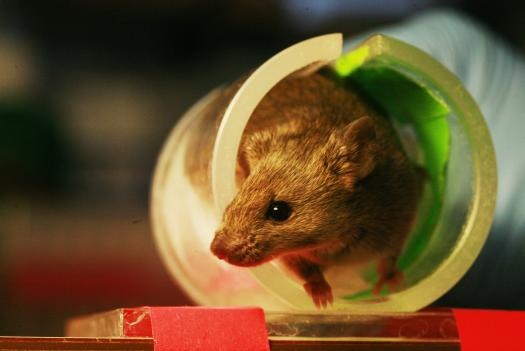

A team of researchers has found a part of the brain that controls how motivated mice are to exercise, according to a new study.
The researchers created genetically modified mice that lacked neurons in the dorsal medial portion of a region of the brain called the habenula.
The major difference was that the mice didn’t like to run on mouse wheels, which normal mice love to do, the researchers reported in a paper they published in the Journal of Neuroscience. “They were physically capable of running, but appeared unmotivated to do it,” Eric Turner, the study’s lead scientist and a brain researcher at Seattle Children’s Research Institute, said in a statement. The mice also had “minor” differences in their gait and balance, compared to normal mice.
Why mess with mouse habenulas? The team was seeking a target for future antidepressant drugs. They knew that some strong science indicates that exercise can help people with depression. What if a future drug could mimic the emotional effects of exercise on the brain?
Of course, there’s a lot of work scientists will have to do before they know whether it’s a good idea to target this brain area for depression. There’s the straightforward issue of checking, with replicating studies, whether this brain region really is responsible for making mice want to exercise. Then scientists will have to see if the analogous region in human brains works similarly. They’ll also want to study whether targeting this brain region improves depression. (What if it just makes you want to exercise, without resolving your depression?) Lastly, it’s always a challenge to design drugs that are safe and effective, even if you’ve got all your targets lined up.
“They were physically capable of running, but appeared unmotivated to do it.”
The lack of running the team documented in the mice may be related to depression, or whatever its murine counterpart might be. The dorsal medial habenula-lacking mice didn’t like sugar water as much as normal mice do, which is a measure of mouse depression. However, dorsal medial habenula-lacking mice did perform the same as normal mice in the forced-swim test, which is another common, if weird, test for hopelessness and depression in mice.
The scientists performed one additional set of experiments that indicate the dorsal medial habenula might be a good target for antidepressants. They hooked mice up to a setup that allowed the mice to turn up or turn down their own dorsal medial habenula. (These are different mice from the mice who lacked dorsal medial habenulas altogether, of course.) The brain-controlling mice always chose to turn their dorsal medial habenulas up, suggesting it’s rewarding to do so. Now if only you could ask the mice exactly what that felt like.
